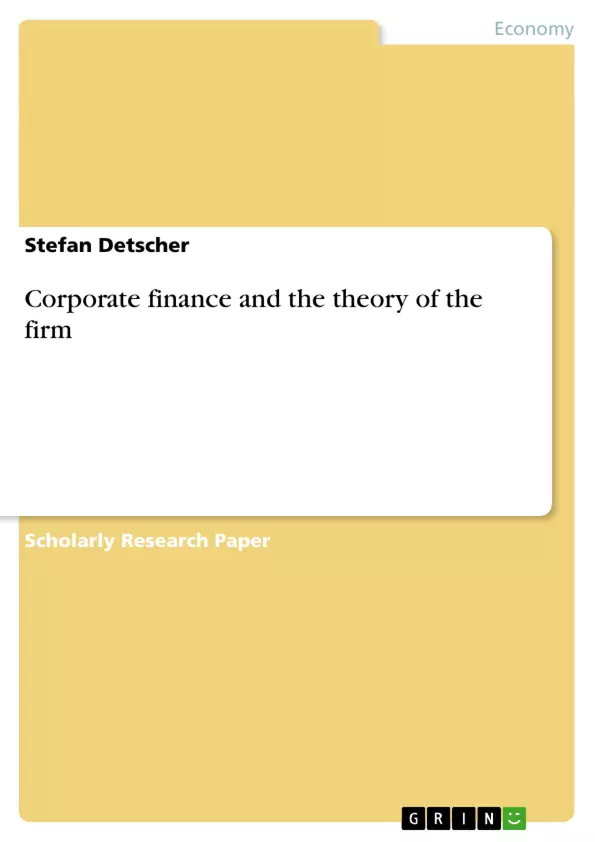This book examines the links between corporate finance and the theory of
the firm. As a basis for this analysis, theoretical foundations in corporate finance and
the theory of the firm are provided. Furthermore, current research on the theory of the
firm and corporate finance for the recently emerged type of firm of the human-capital
intensive firm is presented.
The most significant part of the analysis is the evaluation of the interrelation between
corporate finance and the theory of the firm using a 3x3 matrix. This matrix compares
three important theoretical frameworks of the firm (the firm as a nexus of contracts, as a
collection of growth options and as a collection of assets) with three major fields of
corporate finance (capital structure, corporate governance and valuation). This
assessment is done for the traditional asset-intensive industrial firm, one of two basic
types of firms in today’s economy. For giving an additional insight into current
research, the recently emerged human-capital intensive firm is shortly described in
comparison to the traditional asset-intensive firm, and implications for corporate finance
for this new type of firm are explained.
As a conclusion, three major results can be stated: firstly, the theory of the firm definitely
influences corporate finance for all described views of the firm, and it is thus an
important basis for corporate finance. This fact makes it necessary to consider the underlying
issue of the theory of the firm for each problem in corporate finance. Secondly,
different views of the theory of the firm have different implications for corporate finance.
For example, the appropriate valuation method depends on the considered view
of the firm. A third result being observed is that corporate finance and the theory of the
firm are in an ongoing change. An example of this is the emergence of human-capital
intensive firms within the last decade.
Inhaltsverzeichnis (Table of Contents)
- INTRODUCTION
- PROBLEM AND OBJECTIVE
- STRUCTURE OF THE PAPER
- THEORY OF CORPORATE FINANCE
- DEFINITION AND SCOPE OF CORPORATE FINANCE
- OBJECTIVE OF CORPORATE FINANCE
- FUNDAMENTAL ELEMENTS OF CORPORATE FINANCE
- THEORY OF THE FIRM
- DEFINITION AND EMERGENCE OF THE THEORY OF THE FIRM
- REASONS FOR THE EXISTENCE OF THE FIRM
- DIFFERENT THEORETICAL FRAMEWORKS OF THE FIRM
- LINKS BETWEEN CORPORATE FINANCE AND THE THEORY OF THE FIRM
- SOURCES OF CONNECTION BETWEEN CORPORATE FINANCE AND THE THEORY OF THE FIRM
- EXPLANATION OF THE LINKS BETWEEN CORPORATE FINANCE AND THE THEORY OF THE FIRM ALONG THREE THEORETICAL FRAMEWORKS
- The Firm as a Nexus of Contracts
- The Firm as a Collection of Growth Options
- The Firm as a Collection of Assets
- THE HUMAN-CAPITAL INTENSIVE FIRM: THE NEW TYPE OF FIRM AND ITS IMPLICATIONS FOR CORPORATE FINANCE
- EMERGENCE AND COMPARATIVE DESCRIPTION OF THE HUMAN-CAPITAL INTENSIVE FIRM
- IMPLICATIONS FOR CORPORATE FINANCE
- SUMMARY OF CONCLUSIONS AND RECOMMENDATIONS
Zielsetzung und Themenschwerpunkte (Objectives and Key Themes)
This seminar paper aims to analyze the relationship between corporate finance and the theory of the firm, providing a theoretical foundation for both disciplines. The paper further explores current research on the theory of the firm and corporate finance as applied to human-capital intensive firms, a relatively new type of firm in the business landscape. Key themes and objectives of the paper include: * Analyzing the connection between corporate finance and the theory of the firm. * Examining different theoretical frameworks of the firm, particularly in the context of corporate finance. * Identifying the implications of the theory of the firm for various aspects of corporate finance, such as capital structure, corporate governance, and valuation. * Exploring the emergence of human-capital intensive firms and their impact on corporate finance.Zusammenfassung der Kapitel (Chapter Summaries)
The first two chapters provide a foundation by outlining the key principles of corporate finance and the theory of the firm. Chapter two examines the definition, scope, and objectives of corporate finance, highlighting its importance in both theory and practice. Chapter three delves into the theory of the firm, exploring its emergence and reasons for existence, and then presenting different theoretical frameworks that define how firms operate. Chapter four analyzes the interconnectedness between corporate finance and the theory of the firm, exploring how various theoretical frameworks of the firm influence different aspects of corporate finance. This chapter evaluates the firm as a nexus of contracts, a collection of growth options, and a collection of assets, and how each framework impacts key areas of corporate finance.Schlüsselwörter (Keywords)
This seminar paper focuses on the intricate relationship between corporate finance and the theory of the firm. The primary keywords and focus topics include: corporate finance, theory of the firm, nexus of contracts, growth options, asset collection, capital structure, corporate governance, valuation, human-capital intensive firms, traditional asset-intensive firms. The paper explores how these concepts interact and shape the decision-making processes within modern businesses.- Quote paper
- Stefan Detscher (Author), 2003, Corporate finance and the theory of the firm, Munich, GRIN Verlag, https://www.grin.com/document/24441



